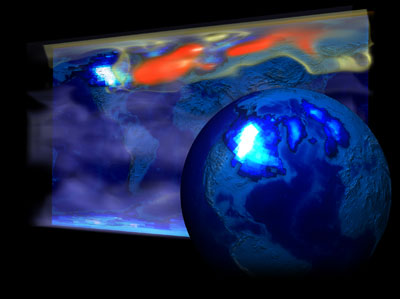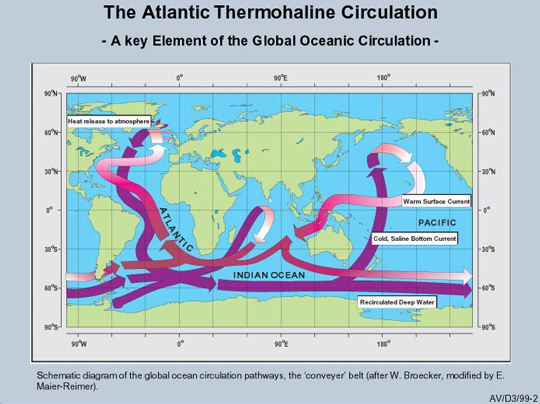New cause for past global warming revealed by massive modeling project
Jul 16, 2009 - by Staff
Jul 16, 2009 - by Staff
BOULDER—By simulating 8,000 years of climate with unprecedented detail and accuracy, a team led by scientists from the University of Wisconsin–Madison and the National Center for Atmospheric Research (NCAR) has found a new explanation for the last major period of global warming, which occurred about 14,500 years ago.
In a period called the Bølling-Allerød warming, global sea level rose by 16 feet and temperatures in Greenland soared by up to 27 degrees Fahrenheit over several hundred years. The new study shows how increased carbon dioxide, strengthening ocean currents, and a release of ocean-stored heat could have combined to trigger the warming.
Findings from the experiment appear in the July 17 issue of Science. The study was funded by NCAR's sponsor, the National Science Foundation (NSF), and by the U.S. Department of Energy (DOE). Simulations were conducted on the Community Climate System Model (CCSM), which is a collaborative effort based at NCAR and supported primarily by NSF and DOE.
 The TraCE-21000 project is examining the Bølling-Allerød, Earth's most recent period of natural global warming on a major scale, which took place about 14,500 years ago. Several factors combined to raise temperatures dramatically over Greenland and parts of Eurasia (red and orange). [ENLARGE] (Illustration by Jamison Daniel, National Center for Computational Sciences, Oak Ridge National Laboratory.)
The TraCE-21000 project is examining the Bølling-Allerød, Earth's most recent period of natural global warming on a major scale, which took place about 14,500 years ago. Several factors combined to raise temperatures dramatically over Greenland and parts of Eurasia (red and orange). [ENLARGE] (Illustration by Jamison Daniel, National Center for Computational Sciences, Oak Ridge National Laboratory.)
"To learn more about future warming, we need to unravel what happened in Earth's past. This study is an important step toward better understanding of how the world's climate could change abruptly over the coming centuries, especially with increasing melting of the ice caps, " says NCAR's Bette Otto-Bliesner. She is co-director of the experiment along with Zhengyu Liu (University of Wisconsin–Madison). Liu and Otto-Bliesner are first and second authors of the Science paper.
Modeling the details for thousands of years
Because climate modeling requires so much computer time, previous simulations of past climate have either used highly complex models to study relatively short periods (a century or two) or simpler models to look at longer periods (thousands of years). This study is the first time a comprehensive, interactive model of the global atmosphere and ocean has portrayed thousands of years of climate.
To launch the experiment, scientists jump-started the CCSM with known changes in Earth's orbit and in carbon dioxide concentration deduced from ice cores and other evidence. They then observed how the atmosphere and ocean responded. The results were in close agreement with temperatures, sea levels, and glacial coverage as deduced from fossil and geologic records.
The study examined the period from 22,000 to 14,000 years ago, as Earth emerged in fits and starts from the extreme cold of the last ice age. Temperatures rose from about 21,000 to 19,000 years ago, then cooled again after glacial meltwater weakened the Atlantic Ocean's warming "conveyor belt," also called the thermohaline circulation.
One mystery the scientists hoped to solve was why global warming resumed so abruptly and strongly during the Bølling-Allerød period, about 14,500 years ago. Previous studies using simpler models had speculated that a sudden shift in the Atlantic Ocean conveyor belt might have caused the Bølling-Allerød warming. However, the new work with the CCSM suggests that three factors each contributed about a third of the warming:
"Once the glacial melt stopped, the enormous subsurface heat that had accumulated for 3,000 years erupted like a volcano and popped out over decades," says Liu. "This huge heat flux melted the sea ice and warmed up Greenland."
 Driven by temperature and salinity variations, large ocean currents convey heat from the equator to the upper latitudes and cold back toward the equator. This constant movement, known as thermohaline circulation, includes such well-known currents as the Atlantic's Gulf Stream, which moderates the climate of northern Europe. [ENLARGE] (Illustration courtesy of CLIVAR Science Figures.)
Driven by temperature and salinity variations, large ocean currents convey heat from the equator to the upper latitudes and cold back toward the equator. This constant movement, known as thermohaline circulation, includes such well-known currents as the Atlantic's Gulf Stream, which moderates the climate of northern Europe. [ENLARGE] (Illustration courtesy of CLIVAR Science Figures.)
Tracing past and present climate change
The current study is only the first phase of a larger project called Transient Simulation of Climate Evolution over the Last 21,000 Years (TraCE-21000). Over the next two years, the researchers will continue to move their simulation of past climate forward through the present and out to the year 2300. All told, the project will employ a total of close to five million computing processor hours at DOE's Oak Ridge National Laboratory, including time on the world's fastest supercomputer for unclassified research.
"We've never been able to recreate climate over this long a period with so much detail and accuracy," says Otto-Bliesner. "Being able to successfully simulate thousands of years of past climate for the first time with a comprehensive climate model is a major scientific achievement."
The interdisciplinary study team includes ocean, climate, geology, chemistry, and computing experts from a wide range of universities, federal laboratories, and nonprofit institutions. "It is a huge—and very successful—collaboration," says Liu.
Title: "Transient Simulation of Last Deglaciation with a New Mechanism for Bølling-Allerød Warming"
Authors: Zhengyu Liu, Bette Otto-Bliesner, Feng He, Esther Brady, Robert Tomas, Peter Clark, Anders Carlson, Jean Lynch-Stieglitz, William Curry, Ed Brook, David Erickson, Robert Jacob, John Kutzbach, Jun Cheng
Publication: Science